Heuchera merriamii is a species of flowering plant in the saxifrage family known by the common name Merriam's alumroot. It is native to the Klamath Mountains of southern Oregon and northern California, where it grows on the rocky slopes. This is a rhizomatous perennial herb producing a patch of leaves which are rounded and have five to seven lobes along the edges. It produces an erect inflorescence up to about 23 centimeters tall with sparse clusters of pinkish, yellow, or cream flowers. The inflorescence is covered in glandular hairs. Each flower has small spoon-shaped petals and protruding stamens.
Bolandra californica is a species of flowering plant in the saxifrage family, known by the common names Sierra bolandra and Sierra false coolwort. It is one of two species in the small genus Bolandra. It is endemic to the High Sierra Nevada of California, where it is an uncommon member of the coniferous forest understory.

Boykinia major is a species of flowering plant in the saxifrage family known by the common name large boykinia. It is native to the western United States from California to Montana, where it grows in shady forest understory and wet mountain meadows. It is a rhizomatous perennial herb producing large leaves with blades up to 50 centimeters long, borne on petioles up to 35 centimeters in length. Each leaf has several lobes which are often sharply toothed along the edges. The inflorescence reaches up to a meter tall on a thin stem. It bears a dense, flat-topped array of many small white flowers with yellowish centers, each with five pointed sepals and five larger rounded or oval petals.

Boykinia occidentalis is a species of flowering plant in the saxifrage family known by the common name coastal brookfoam. It is native to the west coast of North America from British Columbia to California, where it grows in shady areas near riverbanks and streams. It is a rhizomatous perennial herb producing large, rounded leaves with blades up to 45 centimeters long and 12 wide, borne on petioles up to 30 centimeters in length. Each leaf has several rounded lobes with dull teeth along the edges. The inflorescence reaches 30 to 60 centimeters tall on a thin stem. It bears an open array of many small white flowers, each with five tiny pointed sepals and five larger oval petals.
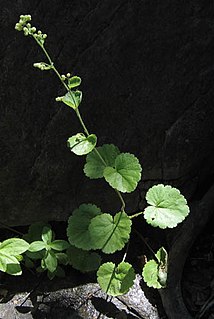
Boykinia rotundifolia is an uncommon species of flowering plant in the saxifrage family known by the common name roundleafed brookfoam. It is endemic to Southern California, where it grows in shady forested areas near streams in the mountains.

Lithophragma affine is a species of flowering plant in the saxifrage family known by the common name San Francisco woodland star. It is native to the coast of western North America from Oregon to Baja California, where it grows in open habitat on mountain slopes, hills, and canyonsides. It is a rhizomatous perennial herb growing erect or leaning with a tall naked flowering stem. The leaves are located on the lower part of the stem, each divided into sharp-pointed lobes. The stem bears up to 15 widely spaced flowers, each in a cuplike calyx of red or green sepals. The five petals are bright white, up to 1.3 centimeters long, and divided into three toothlike lobes at the tips.
Lithophragma bolanderi is a species of flowering plant in the saxifrage family known by the common name Bolander's woodland star. It is endemic to California, where it is known from several mountain ranges, including the North Coast Ranges, the foothills of the Sierra Nevada, and the San Gabriel Mountains. It grows in many types of open habitat. It is a rhizomatous perennial herb growing erect or leaning with a tall naked flowering stem. The leaves are located on the lower part of the stem, each divided into rounded lobes. The stem bears up to 25 flowers, each in a cuplike calyx of red or green sepals. The five petals are white, under one centimeter long, and toothed or smooth along the edges.
Lithophragma heterophyllum is a species of flowering plant in the saxifrage family known by the common name hillside woodland star. It is native to the coastal mountain ranges of California, where it can generally be found in shady habitat. It is a rhizomatous perennial herb growing erect or leaning with a slender naked flowering stem. The leaves are located on the lower part of the stem, each divided into rounded lobes. The stem bears 3 to 12 flowers, each in a cuplike calyx of red or green sepals. The five petals are white, up to 1.2 centimeters long, and usually divided into about three pointed lobes.

Mitella ovalis is a species of flowering plant in the saxifrage family known by the common names coastal miterwort and oval-leaf miterwort. It is native to western North America from southwestern British Columbia, including Vancouver Island, to northern California as far south as Marin County. It grows in moist, shady habitat, such as coastal forests and streambanks. It is a rhizomatous perennial herb growing up to about 35 or 40 centimeters tall. The leaves occur around the base of the stem. They have oval blades up to 5 centimeters wide with toothed, lobed edges. The erect inflorescence bears several flowers, generally 20 to 60, usually along one side of the stem. The distinctive flower is saucer-shaped with five greenish yellow petals which are divided into narrow, whiskerlike lobes.
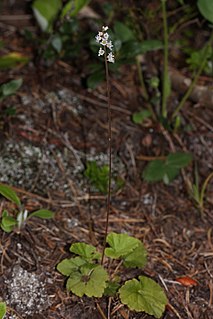
Mitella trifida is a species of flowering plant in the saxifrage family known by the common names threeparted miterwort and Pacific miterwort. It is native to western North America from Alaska to Montana to California, where it grows in wet wooded habitat types. It is a rhizomatous perennial herb growing up to about 45 centimeters tall. The leaves occur around the base of the stem. They have rounded blades up to 10 centimeters wide and lobed, round-toothed edges. The erect inflorescence bears up to 20 flowers, usually along one side of the stem. The distinctive flower is cup-shaped with five white or violet-tinged petals which are usually, but not always, divided into three lance-shaped lobes.

Micranthes aprica is a species of flowering plant known by the common name Sierra saxifrage. It is native to the high mountains of California, including the Sierra Nevada and the southern Cascade Range, and adjacent slopes in southern Oregon and western Nevada. It grows in mountain habitat in areas of alpine climate, such as meadows and next to streams of snowmelt. It is a perennial herb which spends most of the year in a dormant state in order to save water, and rarely flowers. It produces a small gray-green basal rosette of toothed oval leaves up to about 4 centimeters long. When it does bloom, it sends up an erect inflorescence on a peduncle several centimeters tall topped with a cluster of flowers. Each flower has five sepals, five small white petals, and a clump of whiskery stamens at the center.
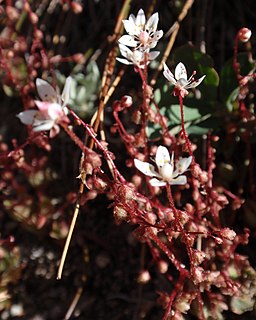
Micranthes bryophora is a species of flowering plant known by the common name bud saxifrage. It is native to the western United States, where its two varieties are geographically separated. The more common var. bryophora is endemic to the mountains of California, and the rare var. tobiasiae is known only from the Payette National Forest of western Idaho.
Micranthes howellii is a species of saxifrage known by the common name Howell's saxifrage. It is endemic to the Klamath Mountains of southern Oregon and northern California, where it grows in moist, rocky habitat. It is a perennial herb growing from a caudex, usually with a rhizome system. It produces a basal rosette of leaves with rounded or oval blades edged with dull or sharp teeth or scalloping. Each leaf is up to 6 centimeters long, thick and fleshy, and borne on a short petiole. The inflorescence arises on an erect peduncle up to 20 centimeters tall. An array of branches bear several flowers with small white petals.

Micranthes integrifolia is a species of flowering plant known by the common name wholeleaf saxifrage. It is native to western North America from British Columbia to Montana and northern California, where it grows in moist habitat, including meadows, prairies, and grassy mountain slopes. It is a perennial herb growing from a caudex and system of rhizomes, and producing a basal rosette of leaves. Each leaf is up to 7 centimeters long with a toothed or smooth-edged blade borne on a short petiole. The inflorescence arises on a stout, hairy peduncle up to 35 centimeters tall. White-petaled flowers occur in a cluster or dense array at the top.
Micranthes nidifica, the peak saxifrage, is a species of plant in the saxifrage family. It is native to the northwestern United States, where it grows in moist habitat, often in mountainous areas. It is a perennial herb growing from a caudex and system of rhizomes and producing a basal rosette of leaves. Each leaf is up to 10 centimeters long with a smooth-edged or minutely toothed blade on a thin petiole. The inflorescence arises on a peduncle up to half a meter tall and bears clusters of flowers with white petals.
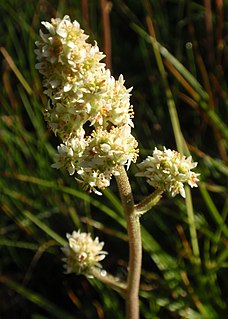
Micranthes oregana is a species of flowering plant known by the common name Oregon saxifrage. It is native to western North America, including the mountainous regions of the western United States. It can be found in moist habitat, such as marshes and other wetlands. It is a perennial herb growing from a thick, fleshy or woody caudex. It produces a basal rosette of linear to lance-shaped leaves each up to 25 centimeters long. The inflorescence arises on a stout peduncle which may exceed a meter in height. It is topped with one or more dense clusters of white-petaled flowers.

Saxifraga rivularis is a species of saxifrage known by several common names, including highland saxifrage, weak saxifrage, alpine brook saxifrage, and pygmy saxifrage.

Micranthes tolmiei is a species of flowering plant known by the common name Tolmie's saxifrage, or Tolmie's alpine saxifrage. It is native to western North America from Alaska to Montana to California, where it grows in rocky mountain habitat types, especially in alpine climates, such as talus and fellfields. It is a small perennial herb growing in mats of creeping stems lined with thick, fleshy leaves each up to 1.5 centimeters long. The inflorescence arises on a stout, erect peduncle with a few stubby bracts midway up. The flowers have narrow white petals and petal-like white stamens.
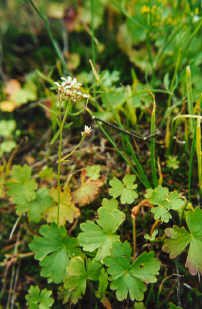
Suksdorfia ranunculifolia is a species of flowering plant in the saxifrage family known by the common name buttercup suksdorfia. It is native to western North America from British Columbia and Alberta south to northern California. It grows in moist, rocky habitat in mountains and foothills. It is a non-rhizomatous perennial herb growing up to 40 centimeters tall. The leaves have rounded blades up to 4 centimeters wide with several large lobes edged with rounded teeth. The blades are light green, slightly fleshy, hairless in texture, and are borne on petioles up to 15 centimeters long. The inflorescence is a dense, flat-topped cluster of up to 35 flowers borne atop a mostly naked, hairy, glandular stalk. Each flower has a bell-shaped calyx of pointed sepals and five white or pink-tipped petals. The fruit is an oval brown capsule measuring 4 millimeters in length.

Micranthes californica, known by the common name California saxifrage, is a species of flowering plants.














